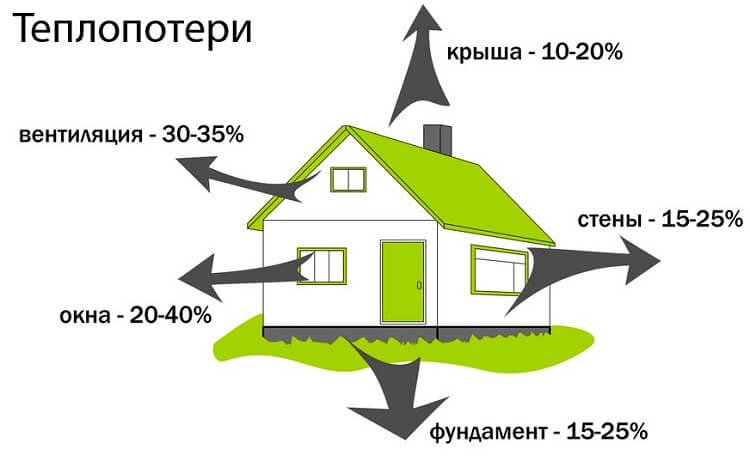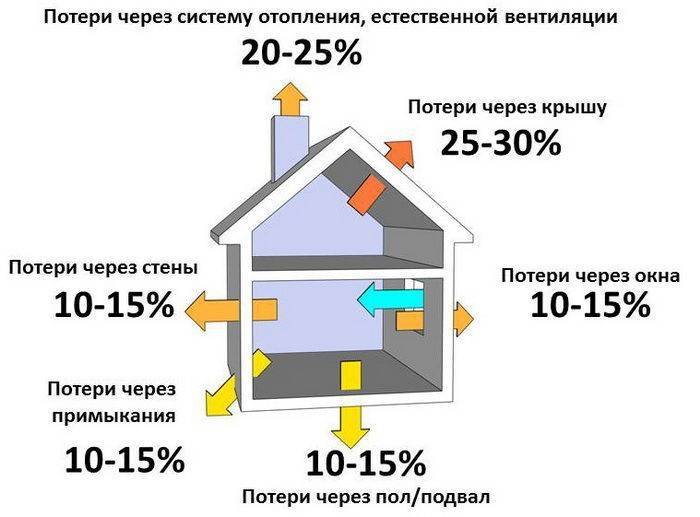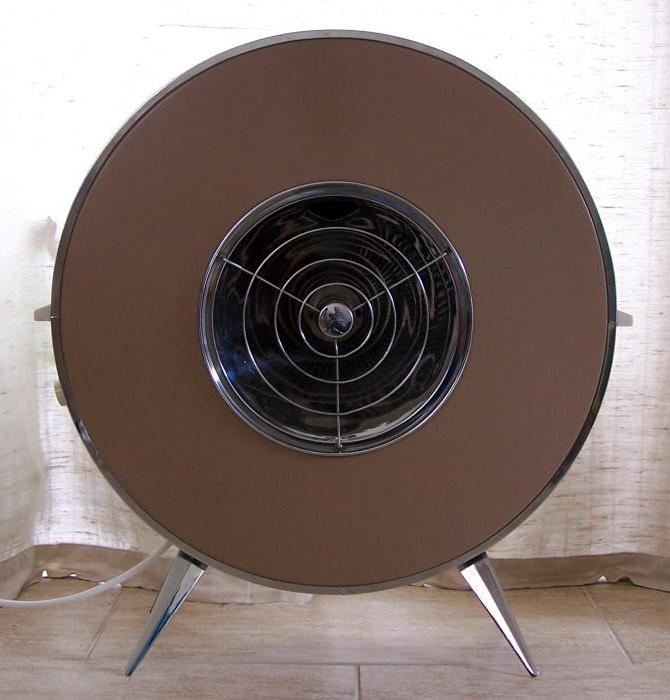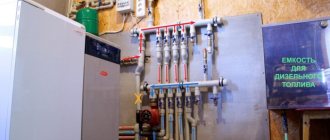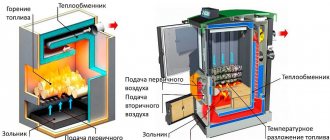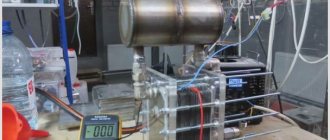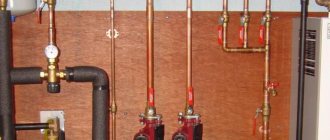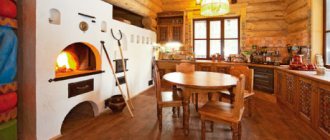The issue of gas saving is especially acute during the heating season. Two factors are pushing towards its solution: the rise in the price of blue fuel and the sharp deterioration of the ecological situation in the global sense. Both owners of private houses and residents of urban high-rise buildings want to reduce costs. There are many techniques. We offer you five types of gas savings for heating a private house that can really help you.
House insulation
This is the first way that comes to mind. To effectively insulate, you need to analyze heat losses. Think about where the cold gets into your home and how the heat goes away. It is logical to assume that most of the heat is lost through windows and ventilation, through walls and roofs. In this regard, it is necessary to take such measures.
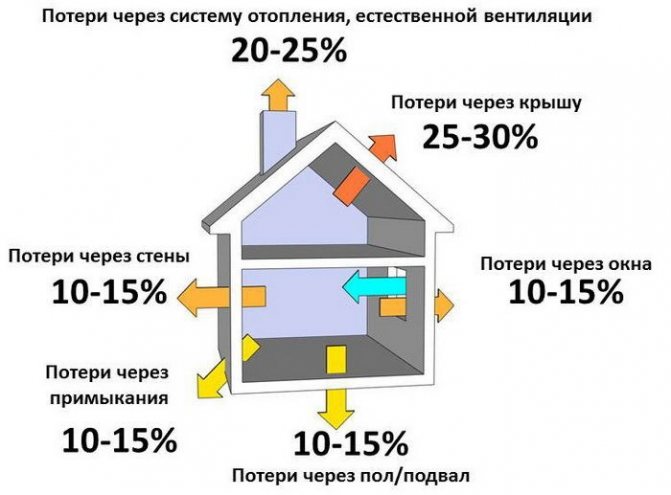
- Insulation of the roof and attic... For this, stone wool or foamed polymers are used. Covering with sandwich panels will be effective. When choosing a method of insulation, technical features and roof structure are taken into account.
- Reduction of heat losses through windows... There is no point in filling up the cracks in old windows. Better to replace them with modern energy-saving systems. On the market you will find double and triple glazed windows. Windows from a multi-contour profile have proven themselves well. Choose based on your own financial capabilities.
- Wall insulation... Front insulation is popular. After proper preparation of the wall, extruded polystyrene foam panels are glued to its outer side of the wall. Their thickness must be at least 20mm. Such a structure is reinforced with a reinforced mesh and plastered.
After completing the work, you will feel how much warmer it will become in your home. Natural gas consumption will immediately decrease by 20-30%. Such a good saving on heating is obtained.
Installing a wall-mounted boiler instead of a floor-standing boiler
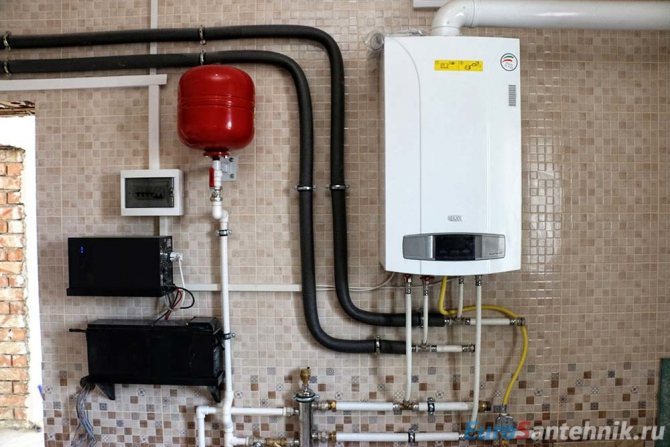

For heating a residential building with an area of up to 400 sq. it is more correct to use a wall-mounted gas boiler. This will allow you to save more on gas. The wall installation can be considered a mini boiler room. It consists of structural elements:
- expansion tank;
- the safety team;
- circulation pump;
- electronic board.
Expensive models have additional elements:
- wireless weather-dependent programmer;
- indirect heating boiler;
- circulation pump with the possibility of frequency regulation.
Single-circuit hinged tanks are often equipped with a three-way valve. It is installed at the junction with the indirect heating boiler. The heat exchangers of the mounted boilers are made of copper or stainless steel.
The main savings on gas can be obtained due to the stable efficiency of the boiler. Unlike floor-standing models, wall-mounted ones most often offer forced draft solutions. The forced draft provides the combustion chamber with the right amount of oxygen. With natural thrust, this indicator is not always stable.
Saving gas when heating, the main ways to reduce fuel consumption
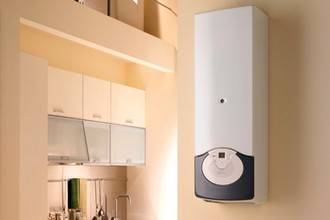

You need to start saving energy from the very beginning - with the purchase and installation of a modern heating boiler.
- The required power of the boiler is calculated based on the following rule: per 10 sq.m. of the heated area of 1 kW of thermal energy, while the height of the ceilings for this calculation is taken not higher than 3 meters. So, a house with an area of 200 sq.m. can heat a boiler with a capacity of at least 20 kW.After carrying out the necessary calculations, a heating unit is purchased with a small tolerance upward and piping is done. The most profitable heat carrier distribution system is considered to be a collector one.
- Such a system makes it possible to regulate the temperature in each room, depending on the frequency of its use by the residents. This can be done manually, or you can install thermostats that will regulate the heat of the water in the radiators.
- Heater automation. There are many different types of automation on the market, from the simplest to the very expensive. For example, one of the new products is thermostats with outdoor air temperature sensors. When the air temperature "overboard" rises, the automatics begins to supply less fuel to the burners, and this is already a real savings in gas when heating a private house.
- According to many experts, the "warm floor" system is a more advantageous type of coolant supply. When installed, warm air is more evenly distributed throughout the building. At the same time, water is supplied to pipes in the floor with a temperature of 65 degrees, and to heating radiators - 95 degrees. However, it becomes more difficult to regulate the temperature in different rooms.
- The provision of hot water for household needs is best organized using a gas flowing water heater (column) or a double-circuit boiler. It should be noted that there is one burner in a double-circuit boiler, so when it heats water for the bathroom, the heating does not work at this time.
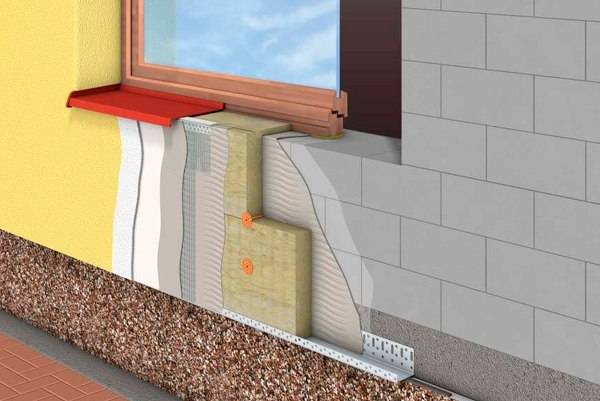

Connecting the thermostat to the boiler
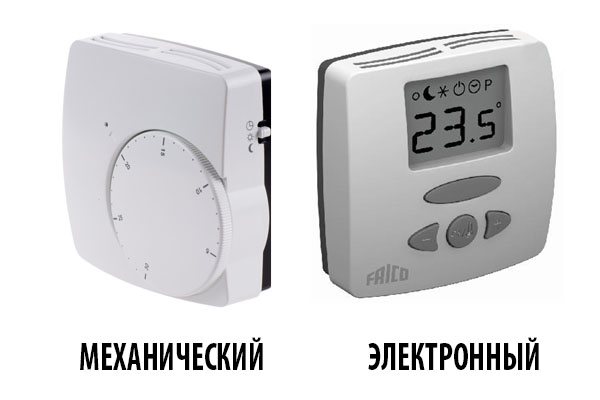

A prerequisite for cost optimization is the automation of the heating process. If the gas supply will not be regulated depending on changes in external factors, it is difficult to talk about saving on heating. Indoor and outdoor temperatures are considered to be such factors. Temperature sensors are used to take readings. They are installed inside and outside the house.
The automation principle is very simple. When the outside temperature changes, a signal about this goes to the boiler control system. The gas flow increases or decreases depending on which parameters have been set. The system constantly tests the indoor air temperature. As soon as the temperature in the house drops below the one you decided to adhere to, the gas supply increases, the boiler starts to work more intensively. The boiler will reduce operation or shut down when the temperature values set by you are reached. Saving does not harm the microclimate, but helps to maintain optimal temperature indicators.
There are boiler models that are equipped with thermostats with programmers. These are the smartest devices. With their help, you can program the temperature dependence. The device will calculate the operating mode by itself.
By using the automatic adjustment method, you prevent unnecessary overheating of the media. This will save 5 to 10% of gas on heating a private house.
How to save gas on the stove and gas water heater
The easiest way to save gas are small "tricks" in the kitchen, which, with constant use, turn into a useful habit:
Avoid excessive boiling of liquid
When cooking with gas, pay attention to the magnitude of the burner flame and do not allow it to heat up the sides of the pan. The highest temperature is on the flames, therefore, to quickly heat the cookware, the fire must be located directly under the bottom of the container. During the cooking process, it is necessary to adjust the flame depending on the cooking stages.
So, for boiling water, the fire can be large, but after that you can reduce the intensity of combustion at least twice.
Helpful hint: cover the dishes with a lid: food will cook faster and less gas is consumed!
Such a bottom design quickly heats up over the entire surface from the center to the edges, while consuming a minimum amount of gas To save fuel when heating water, it is advisable to use special dishes for gas ovens:
- pots with special grooves on the bottom, which retain the temperature for some time after the stove is turned off;
- kettles with a whistle, which will warn you in time that the water has boiled and will not allow you to use excess gas.
If the blue energy carrier is used to heat the column, then installing economical shower heads will help save it. Filling the bathroom also increases the consumption of hot water: it is enough to replace this procedure with a shower and you can get significant gas savings.
Room adjustment
Not all rooms need to be heated equally. It is not necessary to maintain the same temperature in rooms for different purposes. Those requiring increased gas costs include:
- bedrooms and nurseries;
- showers and bathrooms, toilets;
- living rooms and offices.
Non-residential rooms will require less heating:
- storerooms and storage rooms;
- sports or gymnasiums;
- garage premises;
- working workshops.
Regulators are installed separately for each radiator. These are small devices. Their task is to decrease or increase the flow of the coolant volume in the battery. Or a complete overlap of the feed. There are several types of thermostats. Each of them works according to a special principle, has advantages and disadvantages.
- Mechanical... They imply manual adjustment of the coolant volume. The main advantage of mechanical regulators is the low price and simplicity of the device. The degree of heat transfer from the radiator is manually adjustable. You can independently determine the amount of coolant entering the battery.
- Electronic... Readings are taken from remote sensors. The device is based on a programmable microprocessor. There are control buttons on the regulator. With their help, the desired temperature is set. Some models of electronic regulators can control both a pump and a mixer. There are two types of electronic thermal sensors:
- Mechanical thermal heads. This is a valve that at a certain moment squeezes a special fluid. It expands when heated and decreases when it cools. The adjustment error remains.
The installation of thermostats allows you to optimize the gas consumption by choosing the mode of heating the water in the boiler. You can create comfortable conditions in each room. This will save from 5 to 10% of the funds that you pay for gas.
Gas saving methods
The above calculations, which are produced by the gas consumption calculator for heating, relate only directly to the heating of your home. But gas consumption also includes heating water and cooking. In general, in order to save a little gas in a legal way, you can use a few tips.
In addition, please note that your heating equipment - boiler, fittings, additional appliances - must be modern and of high quality. Gas consumption for heating largely depends on this indicator.
For example, if you have a modern boiler that is equipped with a temperature sensor, a circulation pump, then the result will be energy savings when starting a cold system.
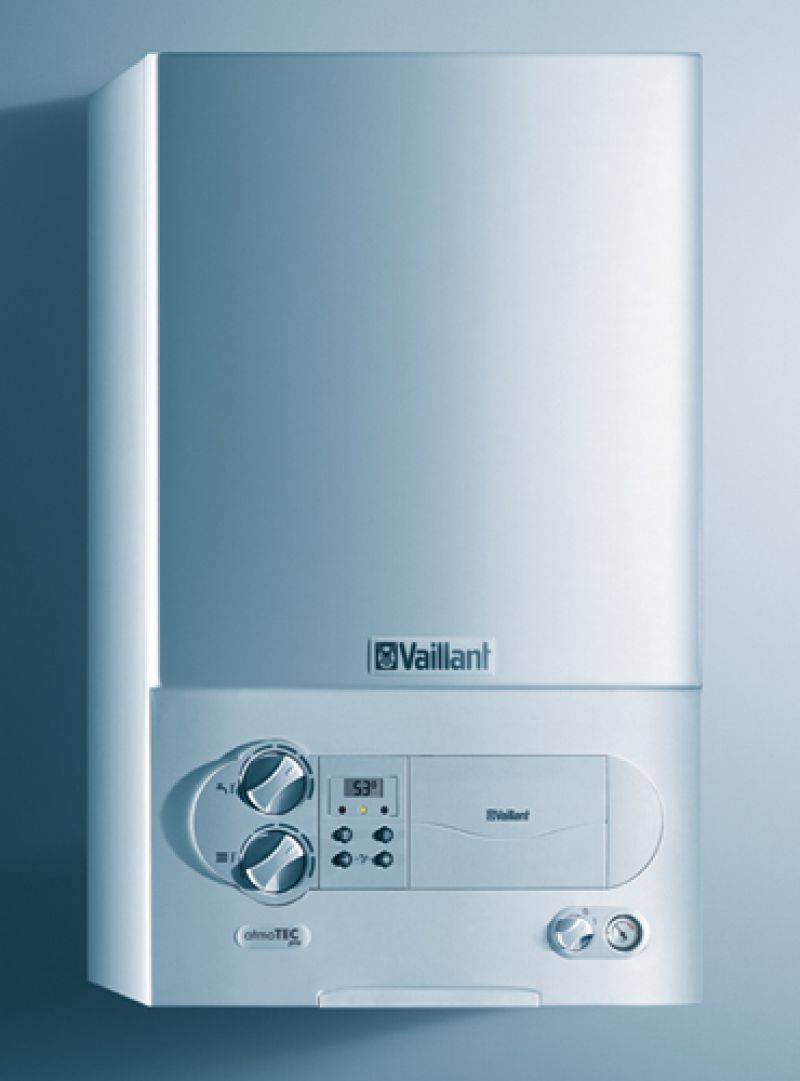

Modern boilers can save up to 20% of gas
If the gas boiler is equipped with a hydraulic arrow on a strap with a frequency-controlled pump and connected to a room thermostat, then it will itself regulate the temperature regime of the water in the system. So, the boiler will turn on less often and its work will be more optimal.If a programmer is provided in the system, then with its help it will be possible to set up such an operation mode when at night or in the absence of the owners of the house, the temperature in the premises will decrease by several degrees, and for some time before arrival or waking up, it will automatically rise to the required indicator ...
Thermal heads can be placed on the battery, and a heat-reflecting foil shield can be placed between the battery and the wall. Also, to ensure free heat dissipation from the batteries, you do not need to close and clutter them with curtains and furniture.
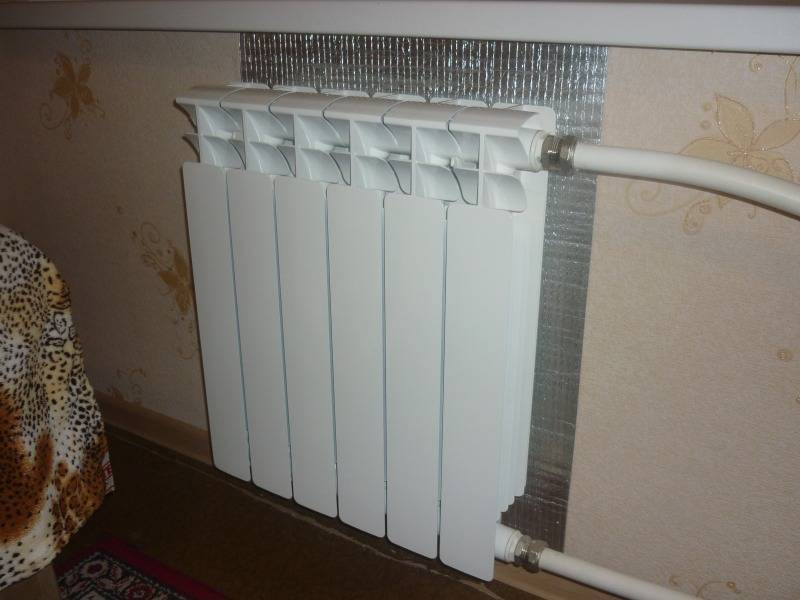

Installing a reflective screen allows heat to be directed into the room, rather than heating the outer walls
It is best to install a gas meter. So, you will pay for the volume of gas you actually used, which is much more profitable than the overestimated rate of gas consumption for heating and other purposes calculated by someone.
It is the same with cooking over high heat: remember that the maximum temperature is only in the area of the flames. Therefore, if the fire spreads more than the diameter of the vessel, then you are simply heating the air. In addition, it can negatively affect some types of cookware.
Installing a condensing boiler
There is another way to achieve savings in comparison with a conventional boiler in 10-15% of the consumption of gas consumed. Install a condensing boiler. The boilers get their name because the system uses the kinetics of water released along with steam.
The technology is based on the laws of physics. After the combustion of the gas, carbon dioxide and water molecules are released. The liquid evaporates and generates heat. Condensation of the resulting steam allows the return of thermal energy, transferring it to the coolant. A special compartment is provided for steam in the condensing unit. It acts as a heat exchanger.
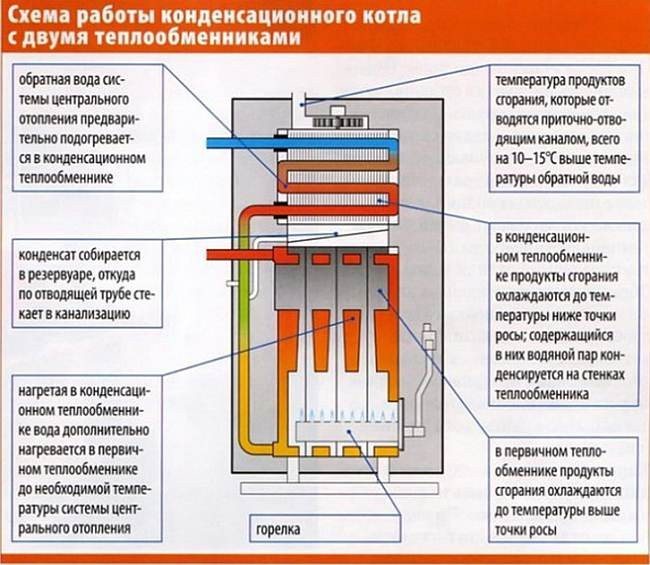

Economical technology is the reason that condensing boilers are used by 70% of the population in Europe. In addition to high efficiency indicators, they have other advantages:
- compact size and light weight;
- the ability to accurately modulate the required temperatures;
- low temperature of exhaust gases;
- low noise level during boiler operation;
- small amount of harmful emissions.
The efficiency of condensing equipment is more than 100%. The main disadvantage of such installations is their very high price. It is on average 50-80% higher than the price of a conventional boiler. The cost depends on the capacity of the installation, the number of circuits with which it is equipped. The material of the heat exchanger, the number of operating modes are also taken into account. It may be that high-tech equipment will not pay off in the first year of its use.
Important! Ideally, such boilers work only in low-temperature heating systems, such as hot water floors. In other systems, the efficiency practically does not differ from traditional wall-mounted boilers.
Method 3: Save money in the kitchen
A large family in a large house consumes a lot of fuel. However, in conditions of large volumes, it is easier to save. You need to adhere to the following rules:
- Prepare some of the food for future use. Some dishes, for example, soup, can be cooked for two days without compromising their nutritional value and taste. At the same time, much less energy is needed for heating than for the initial preparation.
- For cooking, you need to use dishes with a wide bottom. The fact is that the hottest flame is at the top, the temperature is lower at the bottom. However, there is also such a thing as heat transfer. A tall saucepan with a small bottom bottom heats up well at the base, but quickly releases heat to the air at the top. And since this upper part is long, a lot of energy is spent on heating such dishes.
A wide and low saucepan is covered with heat, and the water in it boils much faster.
The choice of material is of great importance. from which the dishes are made.If you are going to cook a dish that requires prolonged heat treatment, then you need to use a material with high thermal inertia, Water in such a dish boils slowly (and this is what is needed for some dishes), but then the dish can languish for a long time on low heat, and most importantly - it can "Reach" already without heating. Cookware with a large amount of aluminum in the alloy has low inertia - water quickly boils and also cools down quickly. Such dishes turn out to be economical when cooking dishes with little heat treatment, when long cooling is less significant than rapid boiling.
Any utensil should be equipped with a well-fitting lid, but with the ability to discharge steam, so that there is no need to cool the contents of the constantly understandable lid.
The most energy-consuming and costly device in the stove is the oven. It should be used only for a large number of dishes. Arrange the oven so that it can hold as much of the cooking utensils as possible. And, of course, you need to take care of the tightness of its door.
A kitchen that is always used for its intended purpose does not need a large number of heating systems. This should be considered when designing heating units.


